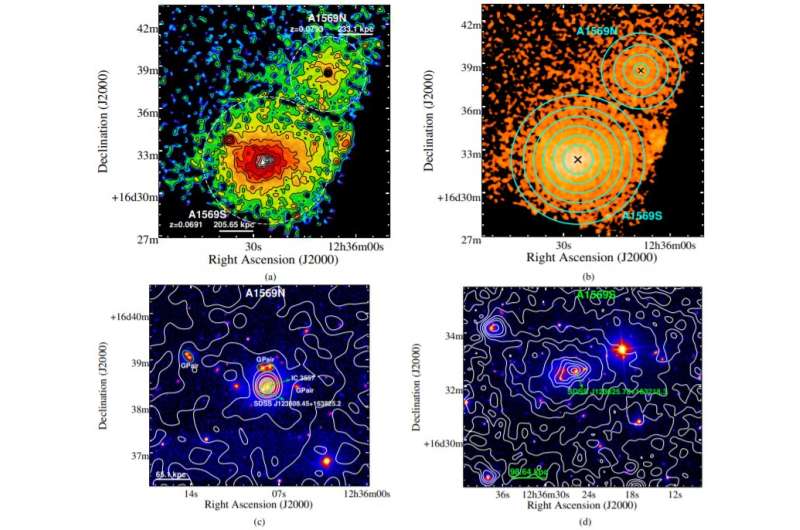November 8, 2021 report
Nearby galaxy cluster Abell 1569 inspected by researchers

Using data from NASA's Chandra X-ray Observatory, Indian astronomers have inspected a nearby galaxy cluster known as Abell 1569. Results of the study, published October 29 on arXiv.org, deliver important insights into the properties of this cluster and its intracluster medium.
Galaxy clusters contain up to thousands of galaxies bound together by gravity. They are the largest known gravitationally bound structures in the universe, and could serve as excellent laboratories for studying galaxy evolution and cosmology.
At a redshift of just 0.0784, Abell 1569 (or A1569 for short) is a nearby galaxy cluster with at least 56 member galaxies. Previous observations of this object have found that it consists of two unbound substructures—a northern subcluster (designated A1569N) and a southern subcluster (A1569S).
The researchers also found that both subclusters of Abell 1569 host extended radio galaxies at their centers. The double-lobed radio source, designated 1233+169, is hosted by A1569N, whereas A1569S harbors a wide-angle-tailed (WAT) radio galaxy known as 1233+168. Given that the nature of these sources and their interaction with the intracluster medium is still poorly understood, a group of astronomers led by Juhi Tiwari of Indian Institute of Science Education and Research, Mohali, India, took a closer look at A1569.
"In this work, we have presented a detailed study of the thermodynamic properties of the intracluster gas in the two subclusters of A1569–A1569N and A1569S," the researchers wrote.
The study found that the two subclusters of Abell 1569 have low X-ray luminosities. The X-ray luminosity of A1569N was measured to be some 4.5 tredecillion erg/s, what means that this subcluster is about five times fainter than A1569S—with X-ray luminosity at a level of 23.1 tredecillion erg/s. The average temperature of A1569N was found to be 1.6 keV while that of A1569S is 1.9 keV.
Chandra observations show that X-ray emission from A1569N and A1569S extends to a radius of about 808,000 and 1,206,000 light-years, respectively. This, according to the astronomers, along with the low temperature and luminosity values confirms that the two subclusters are indeed galaxy groups.
Furthermore, the mass of hot gas for A1569N and A1569S (within radius of X-ray emission) is estimated to be 0.57 and 2.3 trillion solar masses, respectively. Both subclusters appear to have a similar total gravitational mass—which is about 20–21 trillion solar masses. It was noted that A1569N and A1569S lack the presence of a large cool core associated with the intracluster gas.
The research also detected a pair of cavities coincident with extended radio emission from the central galaxy 1233+168 in A1569N. The mechanical power associated with this cavity pair turns out to be an order of magnitude larger than the X-ray radiative loss in the central region of A1569N. The scientists explained that this finding points out to a cavity-induced heating of the gas in A1569N.
When it comes to A1569S, the authors of the paper found possible evidence for a small-scale cluster-subcluster merger. This merger is most likely responsible for the bending of the WAT radio galaxy 1233+168.
More information: Juhi Tiwari, Kulinder Pal Singh, The complex intracluster medium of Abell 1569 and its interaction with central radio galaxies. arXiv:2110.15833 [astro-ph.GA], arxiv.org/abs/2110.15833
© 2021 Science X Network





















